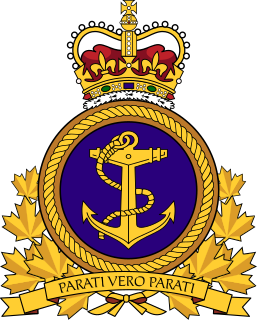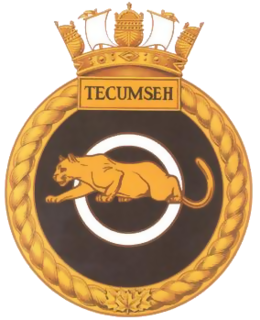
The Royal Canadian Navy is the naval force of Canada. The RCN is one of three environmental commands within the Canadian Armed Forces. As of 2021, the RCN operates 12 frigates, four attack submarines, 12 coastal defence vessels, eight patrol class training vessels, two offshore patrol vessels, and several auxiliary vessels. The RCN consists of 8,570 Regular Force and 4,111 Primary Reserve sailors, supported by 3,800 civilians. Vice-Admiral Craig Baines is the current commander of the Royal Canadian Navy and chief of the Naval Staff.
The history of the Royal Canadian Navy goes back to 1910, when the naval force was created as the Naval Service of Canada and renamed a year later by King George V. The Royal Canadian Navy (RCN) is one of the three environmental commands of the Canadian Forces. Over the course of its history, the RCN has played a role in the First World War, contributed significantly to the Battle of the Atlantic during the Second World War, and was a part of NATO's force buildup during the Cold War. In 1968, the RCN was amalgamated with the Canadian Army and the Royal Canadian Air Force to form what is today the unified Canadian Armed Forces. The naval force was known as Maritime Command until 2011, when the environmental command was renamed as the Royal Canadian Navy.

HMCS Tecumseh is a Canadian Forces Naval Reserve division (NRD) located in Calgary, Alberta. Dubbed a stone frigate, HMCS Tecumseh is a land-based naval training establishment crewed by part-time sailors and also serves as a local recruitment centre for the Royal Canadian Navy (RCN). It is one of 24 naval reserve divisions located in major cities across Canada.

HMCS Chippawa is a Royal Canadian Navy Reserve Division (NRD) located in Winnipeg, Manitoba. Dubbed a stone frigate, HMCS Chippawa is a land-based naval establishment for part-time sailors as well as a local recruitment centre for the Royal Canadian Navy (RCN).

Kingston Airport, also known as Norman Rogers Airport, is a regional airport located 4.3 nautical miles west of the core of Kingston, Ontario, Canada.

HMCS Star is a Canadian Forces Naval Reserve Division (NRD) located in Hamilton, Ontario. Dubbed a stone frigate, HMCS Star is a land-based naval establishment for training part-time sailors as well as functioning as a local recruitment centre for the Royal Canadian Navy (RCN). The second oldest of 24 naval reserve divisions located in major cities across Canada, Star was stood up on 15 March 1923 as the Royal Canadian Naval Volunteer Reserve (RCNVR) Hamilton Half Company and then on 1 November 1941 as HMCS Star.

The Naval Reserve is the Primary Reserve component of the Royal Canadian Navy (RCN). The primary mission of the NAVRES is to force generate sailors and teams for Canadian Armed Forces (CAF) operations, including: domestic safety operations as well as security and defence missions, while at the same time supporting the Navy's efforts in connecting with Canadians through the maintenance of a broad national presence.
Bruno Bitkowski was an all-star Canadian football centre for the Ottawa Rough Riders for eleven seasons. Bitkowski was a Grey Cup champion twice and won the Gruen Trophy as best rookie in the Big Four in 1951. The Ottawa Roughriders retired his number (#40).
The Porte-class gate vessels were a class of five boom defence vessels built in the early 1950s and operated by the Royal Canadian Navy (RCN) and Canadian Forces (CF) during the Cold War. The class derived its name from the gates of the French fortifications of Québec and Louisbourg and was designed by the RCN as a replacement for World War I-era Battle-class trawlers used to operate anti-submarine booms during World War II. The Porte class were used primarily as training vessels during the Cold War.

HMCS Hunter is a Canadian Forces Naval Reserve Division (NRD) located in Windsor, Ontario. Dubbed a stone frigate, HMCS Hunter is a land-based naval training establishment crewed by part-time sailors and also serves as a local recruitment centre for the Canadian Forces Naval Reserve. It is one of 24 naval reserve divisions located in major cities across Canada.

HMCS Brunswicker is a Canadian Forces Naval Reserve Division (NRD) located in Saint John, New Brunswick. Dubbed a stone frigate, HMCS Brunswicker is a land-based naval training establishment crewed by part-time sailors and also serves as a local recruitment centre for the Canadian Forces Naval Reserve and the Royal Canadian Navy (RCN). It is one of 24 naval reserve divisions located in major cities across Canada.
HMCS Cabot is a Canadian Forces Naval Reserve Division (NRD) located in St. John's, Newfoundland and Labrador. Dubbed a stone frigate, HMCS Cabot is a land-based naval training establishment crewed by part-time sailors and also serves as a local recruitment centre for the Canadian Forces Naval Reserve. It is one of 24 naval reserve divisions located in major cities across Canada.

HMCS d'Iberville is a Canadian Forces Naval Reserve Division (NRD) located in Rimouski, Quebec. Dubbed a stone frigate, HMCS d'Iberville is a land-based naval establishment for part-time sailors as well as a local recruitment centre for the Royal Canadian Navy (RCN). It is one of 24 naval reserve divisions located in major cities across Canada.
HMCS Griffon is a Canadian Forces Naval Reserve Division (NRD) located in Thunder Bay, Ontario. Dubbed a stone frigate, HMCS Griffon is a land-based naval establishment for part-time sailors as well as a local recruitment centre for the Canadian Naval Reserve. It is one of 24 naval reserve divisions located in major cities across Canada.
HMCS Radisson is a Canadian Forces Naval Reserve Division (NRD) located on Île Saint-Christophe in Trois-Rivières, Quebec. Dubbed a stone frigate, HMCS Radisson is a land-based naval training establishment crewed by part-time sailors and also serves as a local recruitment centre for the Canadian Forces Naval Reserve. It is one of 24 naval reserve divisions located in major cities across Canada.
HMCS Jolliet is a Canadian Forces Naval Reserve Division (NRD) located in Sept-Îles, Quebec. Dubbed a stone frigate, HMCS Jolliet is a land-based naval training establishment crewed by part-time sailors and also serves as a local recruitment centre for the Canadian Forces Naval Reserve. It is one of 24 naval reserve divisions located in major cities across Canada.
HMCS Queen Charlotte is a Canadian Forces Naval Reserve Division (NRD) located in Charlottetown, Prince Edward Island. Dubbed a stone frigate, HMCS Queen Charlotte is a land-based naval training establishment crewed by part-time sailors and also serves as a local recruitment centre for the Royal Canadian Navy (RCN). It is one of 24 naval reserve divisions located in major cities across Canada.

Canadian Forces Auxiliary Vessel (CFAV) Badger (YAG-319) was one of ten wooden YAG-300 vessels built for the Royal Canadian Navy (RCN) between 1953 and 1955. Built for use as auxiliary craft, Badger primarily served as an at-sea training platform for junior naval officers, boatswains, reserve personnel and Sea Cadets at Canadian Forces Base (CFB) Esquimalt.

Canadian Forces Auxiliary Vessel (CFAV) Grizzly was one of ten wooden YAG 300 vessels built for the Royal Canadian Navy (RCN) between 1953 and 1955. Built for use as auxiliary craft, Grizzly primarily served as an at-sea training platform for junior naval officers, boatswains, reserve personnel and Sea Cadets at Canadian Forces Base (CFB) Esquimalt. Her name perpetuated the WWII armed yacht HMCS Grizzly was reused for PTC 60 GrizzlyOrca-class Patrol Craft Training (PCT) tender that replaced the YAG 300 vessels as the RCN training tenders in 2008.










